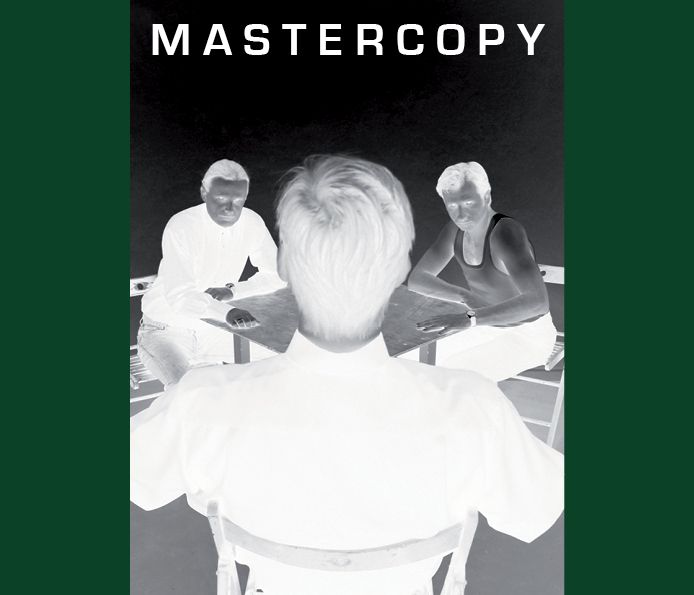A conversation between Pia Hovi-Assad and Lars Breuer, Sebastian Freytag and Guido Münch
„All living art is the history of the future. The greatest artists, men
of science and political thinkers, come to us from the future –
from the opposite direction to the past.“
(Wyndham Lewis, 1922)
PH-A: The Media Point is like an encyclopaedia of art, philosophy
and popular culture. What is the „trialogue“? The conversation
between you three and your ideals; in what way do past ideals
become apparent in your art?
Sebastian Freytag: The Media Point is more than an encyclopaedia
of art, it is a accumulation of ideas – an Olympus of visions
or maybe a waste dump of void visions from the past. We made
copies of book covers in our bookshelves. By choosing some of
the copies and putting them in a certain order we want to express
our desires towards ideas and to create contrasts, upgrading or
downgrading the content. The copywall is a compilation of keywords,
and it can be read as a big collage of visions and ideas.
There is no conclusion that can be drawn, no logical order of the
whole. But all decisions can be explained. Ludwig Wittgenstein,
Star Wars and Valori Plastici might not have something in common
in the same way that Jaques-Louis David, H.-G. Wells‘ Time
Machine and Lascaux have nothing in common, but quoting the
titles creates a deep impact and leads to an unexplainable clash
in the mind.
We created the compilation together so that the recipient cannot
see any specific authorship.
Guido Münch: All influences meet on the same surface and can
neutralise or amplify each other. Just as on an equalizer you
have three different modes: positive, negative or zero.
PH-A: Each one of you has created a work in the Wing. The
space turned out to be a big installation in which the works are
in dialogue with each other and with the space. Can the Wing be
seen as ‚your kind of pavilion‘, a Gesamtkunstverk?
Lars Breuer: It is possible to look at the works in the Wing in a
very classical way. If you enter the room you can concentrate on
Guido‘s painting before walking over to my big triptych. But you
can also consider the presentation as a single installation consisting
of different media. We think that ‚composition‘ is not only
a question of individual artworks – it is a question of presentation
in general. The idea of Gesamtkunstwerk affects us a lot and in
this we will follow architects and colleagues.
Guido Münch: The idea of a Gesamtkunstwerk can also fall
apart and the artworks start to compete with each other.
Sebastian Freytag: All big movements of art lead to the idea of
a Gesamtkunstwerk even if the specific term might be younger.
Bauhaus did, and Russian Avantgarde and L‘Esprit nouveau did
as well. If you look back, you find this idea in the past such as in
Brunelleschi‘s Cappella dei Pazzi.
PH-A: How important is it for you to distinguish the techniques
and materials you use in your works?
Lars Breuer: If you look at our exhibitions you will always find
different media and also different techniques. Posters are facing
paintings. A monolithic figurative oil painting faces a serial structure
of prints. Even the individual works themselves consist of
arrangements made of different structures. Techniques and materials
are part of the composition.
PH-A: Could you define the terms:
Prototype
A prototype is an original type, form or instance serving as a typical
example, basis or standard for other things of the same type.
Thus a prototype is made for reproduction, and is itself always
a combination of different elements of ‚older‘ reproductions and/
or prototypes.
Unique
We know that the unique self-identity of every artist is determined
by others, who mirror him or her.
Mastercopy
A modern expression for ‚Mastercopy‘ might be ‚pirate copy‘ or
‚fake‘ or ‚unoriginal reproduction‘. We have to notice that only the
work is a ‚copy‘. The artist is the neutral element and arranger of
affirmation.
Reproduction
REPRODUCTION is the debut album by the British synthpop
band THE HUMAN LEAGUE. The album was released in October
1979 through VIRGIN RECORDS Ltd.
One first needs to remove all constrictions of awareness before
activities such as choosing, reproduction, exploiting, and modifying
can be perceived.
Raubkopie versus pirate copy
Maybe you can be such a good pirate that you don‘t have to steal
anything anymore. (Jack Sparrow)
Logo
A logo is a graphic mark or emblem commonly used by commercial
enterprises, organisations and even individuals to aid and
promote instant public recognition. (Wikipedia)
PH-A: The cube, which you have created in the Sculpture Garden,
is an artwork/installation situated between two exhibition
spaces, between two different types of architecture, between
different types of art. It functions as a link between modern and
contemporary art. Was this your intention or did it happen by
chance?
Guido Münch: The Sculpture Garden is a field between the old
building from the 19th century and the new part from the 1990s.
The cube and the Sculpture Garden can be seen as a link between
the past and the future just like the monolith in Stanley
Kubrick‘s movie Space Odyssey – shifting back and forth on the
time continuum. Maybe the cube is a mark of the present between
the past and the future – like a futuristic astronaut in a
19th-century hotel room. The passage of time is merely what the
human mind thinks is happening. We are in fact moving through
space-time, but our brain is incapable of realising this. We are
not aware of the motion of the Earth and we still see the Sun rising up – not the motion of the Earth. It is the same with time
which seems to be passing. But a physical fact is that the past,
the present and the future exist on the same level of time (theory
of the block universe).
PH-A: The cube in Pori contains the same elements as the cube
you created for your exhibition in Ludwigshafen, but the cube
in Pori has been created in a new way: Konsortium working together
to create one artwork. Is this the first time you used this
new method?
Sebastian Freytag: We are just starting to develop this possibility.
The reference walls with the photocopies function in a similar
way as collective works.
Lars Breuer: The differences to Ludwigshafen are not too big.
There, the cube formed the ground for paintings on canvas, whereas
in Pori we painted directly on the cube. But both cubes work
like basic architectural elements, with four sides for three artists
and one side for references. An architectural structures becomes
the surface for intellectual content. In Pori, it was a new experience
to work on an outdoor sculpture. This is an interesting path
we will follow.
PH-A: You have created another exhibition in Pori Art Museum‘s
Project Room, entitled Cover Version. The exhibition consists of
works from the Maire Gullichsen Art Foundation, which is one of
the museum‘s main collections. How do you see your art connecting
with French, Scandinavian and Finnish Modernism, for
example the Finnish modernist Lars-Gunnar Nordström?
Sebastian Freytag: The collection of the museum can be regarded
as a memory bank. This memory bank is part of a bigger
continuum, just like a server in which different memory banks
are interconnected. From there you have access to all artworks.
Artists have always had the possibility to enter the memory pool
of the bank to use it as a source. Geographic boundaries play
less and less a role in this. In Pori, we just entered the bank and
asked for credit. We borrowed some older art forms and used
them as an investment in our new works. Several years earlier
Unto Pusa did the same when he referenced Robert Delaunay.
PH-A: If there is a connection between you and these artists,
how does this appear in your own artistic production?
Lars Breuer: Our basic approach in the Cover Version exhibition
was quite different: Guido referred to an Unto Pusa painting
by using the same format and a similar composition. In my
own painting (Motorradlärm, 2001) I used new colours to create
a counterpart to a piece by Lars-Gunnar Nordström. And finally,
Sebastian used on the other side of the gallery a motif from Lars-
Gunnar Nordström to create a serial structure which serves as a
background pattern for a series of framed prints by Sam Vanni.
So Sebastian placed modular elements on a serial structure.
PH-A: Konsortium has created a series of postcards for the Pori
Art Museum in connection with the two exhibitions. How do the
postcards reflect Varvara Stepanova‘s statement „Study the old
but create the new?“ that you use as your motto?
Sebastian Freytag: These postcards should be used by future
artist to refer to our work just as we did with former postcards of
the museum. Artis est monstrare artem.
PH-A: Pori Art Museum‘s pedagogical program is very extensive,
and the pedagogical unit co-operates with local kindergartens
and schools. Children have had a chance to learn to know your
art and create their own versions of your works in a workshop.
How does it feel to be copied and to be studied as a „mastercopy“?
Guido Münch: The new generation of artists has already arisen.
Pori / Düsseldorf, 2010



